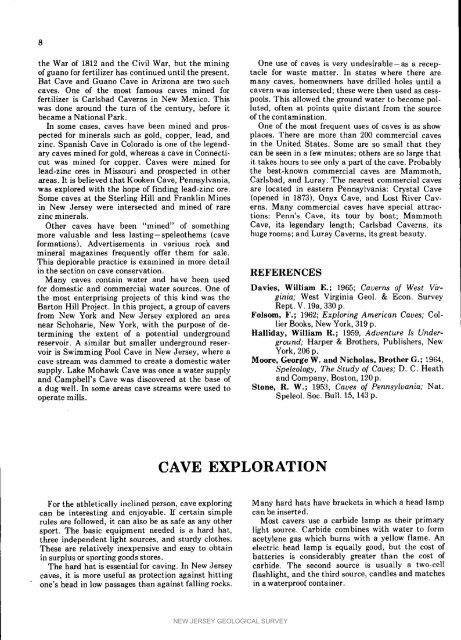Bulletin 70. Caves of New Jersey, 1976 - State of New Jersey
Bulletin 70. Caves of New Jersey, 1976 - State of New Jersey
Bulletin 70. Caves of New Jersey, 1976 - State of New Jersey
You also want an ePaper? Increase the reach of your titles
YUMPU automatically turns print PDFs into web optimized ePapers that Google loves.
8<br />
the War <strong>of</strong> 1812 and the Civil War, but the mining One use <strong>of</strong> caves is very undesirable-as a recep<strong>of</strong><br />
guano for fertilizer has continued until the present, tacle for waste matter. In states where there are<br />
Bat Cave and Guano Cave in Arizona are two such many caves, homeowners have drilled holes until a<br />
caves. One <strong>of</strong> the most famous caves mined for cavern was intersected; these were then used as cessfertilizer<br />
is Carlsbad Caverns in <strong>New</strong> Mexico. This pools. This allowed the ground water to become polwas<br />
done around the turn <strong>of</strong> the century, before it luted, <strong>of</strong>ten at points quite distant from the source<br />
became a National Park. <strong>of</strong> the contamination.<br />
In some cases, caves have been mined and pros- One <strong>of</strong> the most frequent uses <strong>of</strong> caves is as show<br />
pected for minerals such as gold, copper, lead, and places. There are more than 200 commercial caves<br />
zinc. Spanish Cave in Colorado is one <strong>of</strong> the legend- in the United <strong>State</strong>s. Some are so small that they<br />
ary caves mined for gold, whereas a cave in Connecti- can be seen in a few minutes; others are so large that<br />
cut was mined for copper. <strong>Caves</strong> were mined for it takes hours to see only a part <strong>of</strong> the cave. Probably<br />
lead-zinc ores in Missouri and prospected in other the best-known commercial caves are Mammoth,<br />
areas. It is believed that Kooken Cave, Pennsylvania, Carlsbad, and Luray. The nearest commercial caves<br />
was explored with the hope <strong>of</strong> finding lead-zinc ore. are located in eastern Pennsylvania: Crystal Cave<br />
Some caves at the Sterling Hill and Franklin Mines (opened in 1873), Onyx Cave, and Lost River Cavin<br />
<strong>New</strong> <strong>Jersey</strong> were intersected and mined <strong>of</strong> rare erns. Many commercial caves have special attraczinc<br />
minerals, tions: Penn's Cave, its tour by boat; Mammoth<br />
Other caves have been "mined" <strong>of</strong> something Cave, its legendary length; Carlsbad Caverns, its<br />
more valuable and less lasting- speleothems (cave huge rooms; and Luray Caverns, its great beauty.<br />
formations). Advertisements in various rock and<br />
mineral magazines frequently <strong>of</strong>fer them for sale.<br />
This deplorable practice is examined in more detail<br />
in the section on cave conservation. REFERENCES<br />
Many caves contain water and have been used<br />
for domestic and commercial water sources. One <strong>of</strong> Davies, William E.; 1965; Caverns <strong>of</strong> West Virthe<br />
most enterprising projects <strong>of</strong> this kind was the ginia; West Virginia Geol. & Econ. Survey<br />
Barton Hill Project. In this project, a group <strong>of</strong> cavers Rept. V. 19a, 330 p.<br />
from <strong>New</strong> York and <strong>New</strong> <strong>Jersey</strong> explored an area Folsom, F.; 1962; Exploring American <strong>Caves</strong>; Colnear<br />
Schoharie, <strong>New</strong> York, with the purpose <strong>of</strong> de- liar Books, <strong>New</strong> York, 319 p.<br />
termining the extent <strong>of</strong> a potential underground Halliday, William R.; 1959, Adventure Is Underreservoir.<br />
A similar but smaller underground reser- ground; Harper & Brothers, Publishers, <strong>New</strong><br />
voir is Swimming Pool Cave in <strong>New</strong> <strong>Jersey</strong>, where a York, 206 p.<br />
cave stream was dammed to create a domestic water Moore, George W. and Nicholas, Brother G.; 1964,<br />
supply. Lake Mohawk Cave was once a water supply Speleology, The Study <strong>of</strong> <strong>Caves</strong>; D. C. Heath<br />
and Campbell's Cave was discovered at the base <strong>of</strong> and Company, Boston, 120 p.<br />
a dug well. In some areas cave streams were used to Stone, R. W.; 1953, <strong>Caves</strong> o[ Pennsylvania; Nat.<br />
operate mills. Speleol. Soc. Bull. 15, 143 p.<br />
CAVE<br />
EXPLORATION<br />
For the athletically inclined person, cave exploring Many hard hats have brackets in which a head lamp<br />
can be interesting and enjoyable. If certain simple can be inserted.<br />
rules are followed, it can also be as safe as any other Most cavers use a carbide lamp as their primary<br />
sport. The basic equipment needed is a hard hat, light source. Carbide combines with water to form<br />
three independent light sources, and sturdy clothes, acetylene gas which burns with a yellow flame. An<br />
These are relatively inexpensive and easy to obtain electric head lamp is equally good, but the cost <strong>of</strong><br />
in surplus or sporting goods stores, batteries is considerably greater than the cost <strong>of</strong><br />
The hard hat is essential for caving. In <strong>New</strong> <strong>Jersey</strong> carbide. The second source is usually a two-cell<br />
caves, it is more useful as protection against hitting flashlight, and the third source, candles and matches<br />
one's head in low passages than against falling rocks, in a waterpro<strong>of</strong> container.<br />
NEW JERSEY GEOLOGICAL SURVEY

















